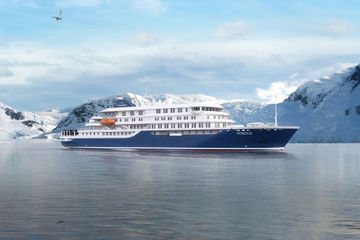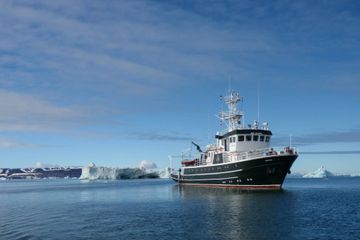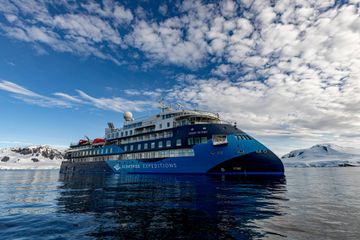Popular Arctic cruise ships Explore all cruise ships
Small Ship Cruises in Arctic
A special destination with abundant wildlife and a chance to gaze on the natural wonder that is the Aurora Borealis.
Arctic cruises are the perfect way to enjoy a truly untouched part of the world and experience a real adventure. Adventurous travellers have always sought out the arctic circle for the chance to encounter wildlife and dramatic landscapes unlike any others. Unlike the Antarctic, the Arctic is home to not only special wildlife but also small hardy human populations with cultures just as unique.
A cruise in the Arctic Circle offers the opportunity to explore completely new landscapes with glaciers, sea ice and frozen tundra all found here. Each of these landscapes supports different kinds of animal life with everything from polar bears to musk ox. At sea, humpback whales and orcas can be spotted, many migrating up to the Arctic to feed on herring shoals and seal colonies.
The Greenland Sea is one of the highlights of any Arctic ocean cruise, with huge expanses of ice and picture-perfect formations. This is also one of the largest hooded and harp seal breeding grounds in the world, attracting orcas. Better known as killer whales, orcas are a beautiful sight swimming through the Greenland Sea in their pods. The bowhead whale is also a common sight, especially as their numbers have been increasing in recent years; this is the only whale to live exclusively in Arctic waters.
Norway is a favorite point of interest for Arctic small-ship cruises. The north of Norway is a visually stunning part of the world. The landscape is mountainous with striking fjords and huge waterfalls. Many visitors are drawn there to witness the phenomenon of the Northern Lights, which can be seen most of the year around the North of Norway.
Many Polar cruises also take in the coastline of Northern Norway, including the island of Spitsbergen in the Svalbard archipelago. This area is of prime interest for arctic wildlife encounters with polar bears, reindeer, and arctic foxes on the land. In the ocean and on the coast, expect to see walruses, dolphins, whales, and huge numbers of seabirds. This region is also home to several fjords and glaciers, perfect for hiking and photography.
Iceland is a popular departure point for Arctic Ocean cruises and is home to various adventure activities for visitors. Hiking on glaciers and kayaking allow you to see some fascinating landscapes and finish off with a dip in a geothermal spa. Geysers are also intriguing; huge water spouts blow up from the earth and make for a spectacular show. Wildlife is also abundant in Iceland, with arctic foxes, puffins, reindeer on land, walruses, whales, and dolphins in the ocean.
On the other side of the Arctic, Northern Canada is one of the few areas inhabited in the region. Polar cruises in Northern Canada allow their guests to meet local Inuit communities and experience their unique culture. You can spot polar bears, arctic rabbits, musk oxs, and walruses on the ice-packed landscape. Photographers will also find huge icebergs and glacial formations on land, perfect for taking fantastic landscape shots.
Aside from all the adventure and wildlife, one particular sight draws many people to the Arctic Circle, the Northern Lights, or the Aurora Borealis. This spectacular space light show can be witnessed from Northern Norway, with cruises chasing the forecast to give their guests the chance to witness what happens when electrically charged particles from the sun enter our atmosphere.
Best time to cruise the Arctic
The best time to visit the Arctic depends on what you want to see and what activities you want to do on your trip. The season for Arctic Ocean cruises is from May until September when the ice melts, and small ship cruises can pass through to explore the region without being blocked by surface ice. During this period, the region enjoys 24-hour, often sunny days, perfect for wildlife spotting and photography. In the Arctic in September the weather starts to get colder and the days shorter, however, this is the best time to see the Northern Lights.
At the start of the season until the middle of June is the best time for those who want to see the ice formations before they thaw in the warmer months. Icebergs can still be seen during this period, and this is one of the best times to spot humpback whales. June is the peak season for narwhals. Polar bears and walruses can be spotted on the ice hunting when groups explore areas from zodiac boats.
The temperatures start to increase at the end of June, melting ice and exposing the arctic tundra, which blossoms and allows more hiking activities. This is the best time to see wildlife such as the musk ox, arctic foxes, and seabirds that migrate around mid-June. Visitors can expect to see puffins, terns, and kittiwakes, which have come to nest around Iceland and the Faroe Islands at this time of year.
How to get to the Arctic
Reaching Northern Norway is possible by flight to Spitsbergen from Oslo or Tromsø airports, which connect to several international destinations. Some trips that take in the Scottish Islands and Faroes, as well as Norway, depart from Edinburgh in Scotland. Edinburgh has an international airport with links to Europe and further afield. Iceland is best accessed by flight to Reykjavik International Airport; most cruises departing from Iceland begin in Reykjavik harbor. Conversely, the Canadian Arctic is reachable by flight from Ottawa in the Ontario region of Canada to Iqaluit on Baffin Island.
Where do Arctic cruises depart from?
Arctic cruises to the Longyearbyen area of Northern Norway can depart from Spitsbergen harbor on Longyearbyen, which is accessible by flight from mainland Norway. Alternatively, cruises may take in both Iceland and Longyearbyen; these will depart from Reykjavik or Spitsbergen or begin at one of these ports and finish in the other. It is also possible to fly to Constable Pynt Airport in Iceland as an alternative to Reykjavik. Some will also depart from Edinburgh in Scotland; these trips normally include the Scottish islands and Norwegian Fjords as part of the trip.
Arctic Cruise Tips
Arctic small-ship cruises are a proper adventure experience and have a small window of opportunity when the region is accessible by boat. It is wise to plan any trip to the Arctic well in advance, not only because of limited availability but also because it is important to know all the details when undertaking an expedition such as this.
One of the great appeals of the Arctic is its remoteness and extreme weather conditions; however, these are worth considering when making travel arrangements as well. Delays are common, considering the weather conditions and the importance of safety in such a remote location. It is advisable to arrive a few days before your cruise departs to avoid any risk of missing the departure.
Be sure to check the best time of year to visit the Arctic for activities that meet your interests. Check through the itineraries as well to ensure you can participate in all of the cultural experiences and wildlife watching you are hoping for. For example, if you want to go hiking and birdwatching, check the season in the region you are visiting. Also, some regions are better for certain wildlife, with the Canadian Arctic great for muskox, arctic foxes, and arctic rabbits.
The remoteness of the Arctic means that bringing everything you need is very important. You will find that the big departure cities like Reykjavik have ample facilities, but once you depart, you will unlikely have an opportunity to pick up anything you forgot. It may sound surprising that sunscreen is one of the must-have items in the Arctic, but the 24 hours of sunshine make it a necessity. Warm clothes are a must, and although many trips offer jackets for guests, many people choose to bring their own for comfort.
Depending on your departure point, you may need a visa to travel to the Arctic. The visa requirements will depend on the agreement between the departure country and your home country. Most do not require a visa for Iceland or Norway, but you will need a valid passport or EU identity card. Non-EU citizens may also have to provide sufficient funds to sustain themselves on their trip. The most common currencies in the Arctic are the Icelandic Krona, Norwegian Krone, and Canadian Dollar. Cards are widely accepted, and it is worth noting that these countries are fairly expensive. It is wise to ensure you have sufficient money for your trip.
Arctic Reviews
- 8.8 Fabulous
- 2 Verified Reviews
Highly recommended.
Cruising Arctic in July on the Hondius









